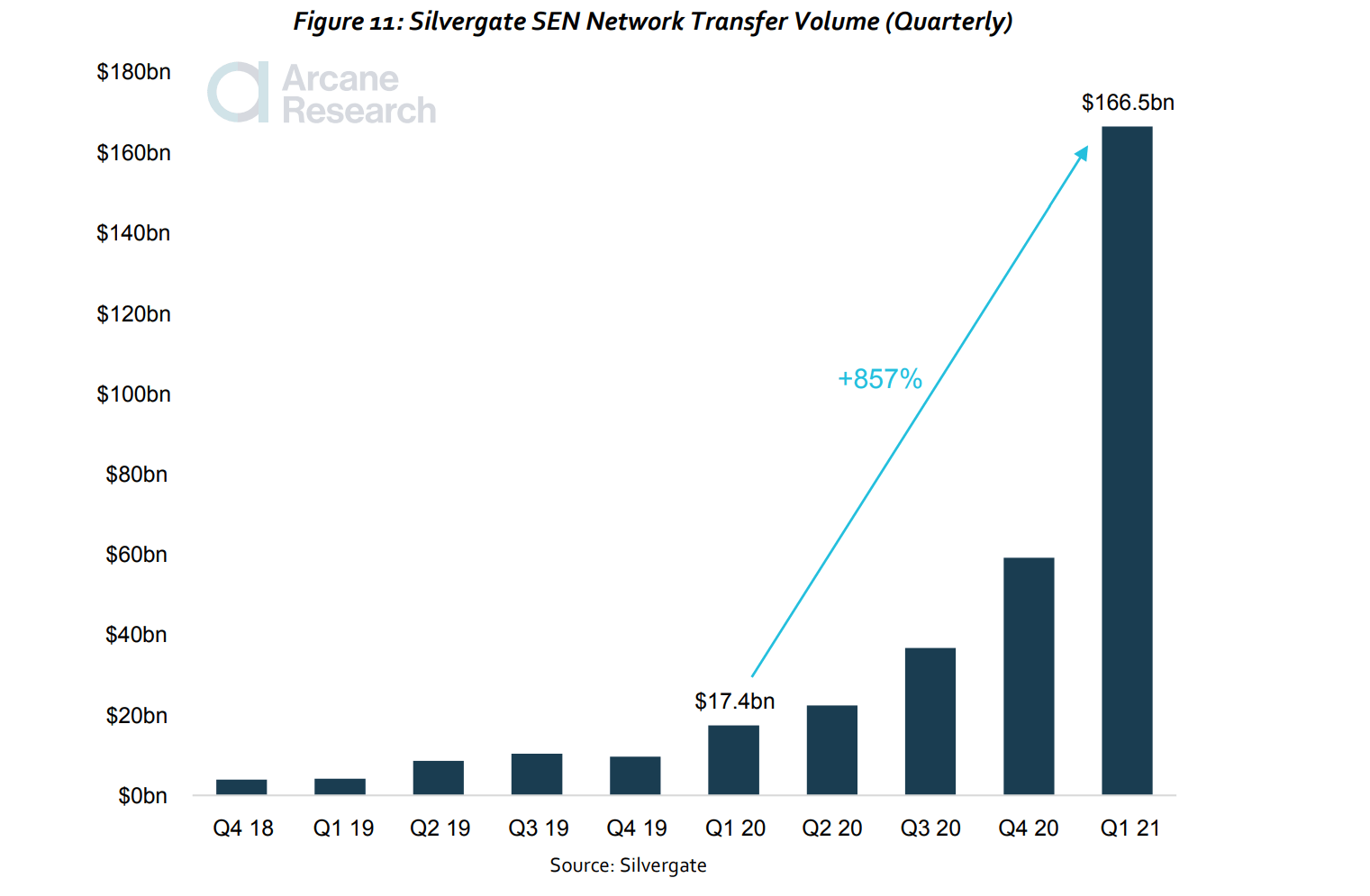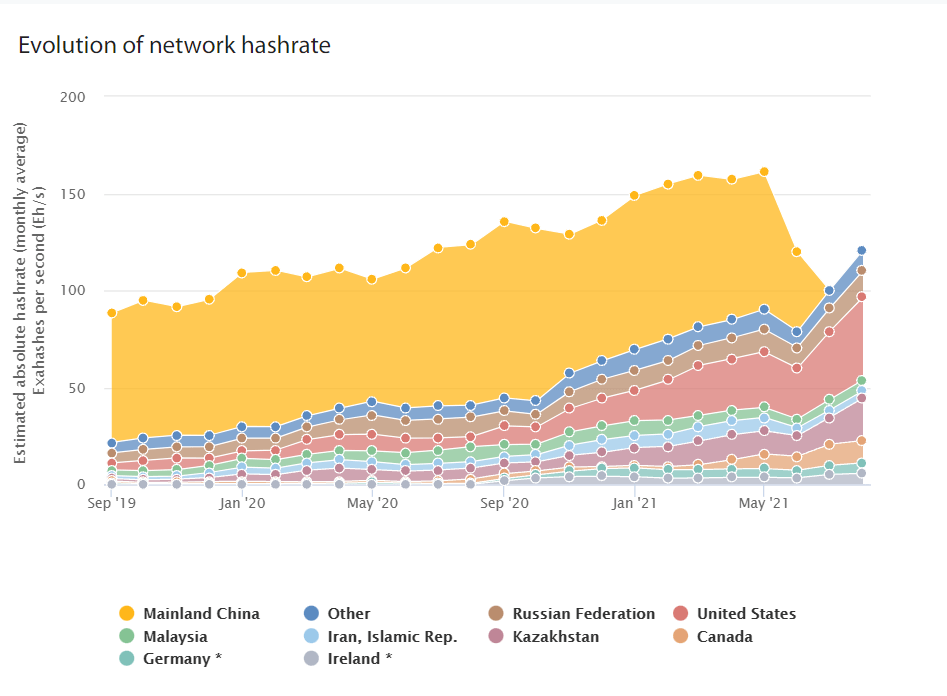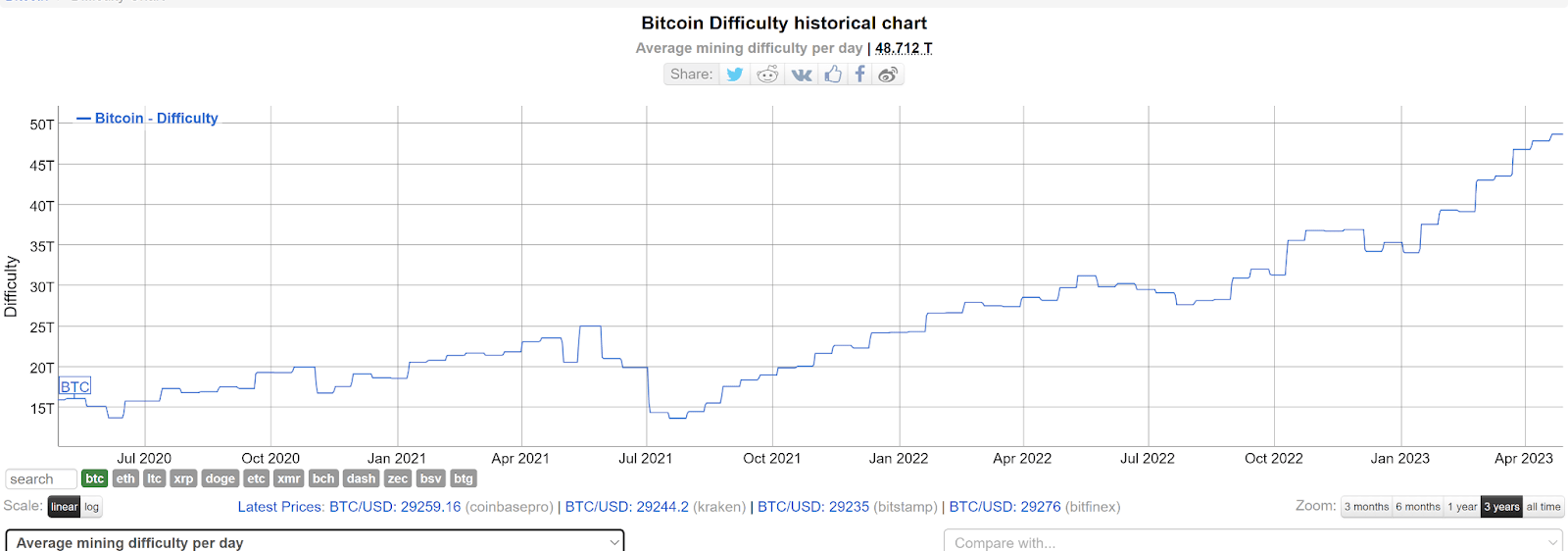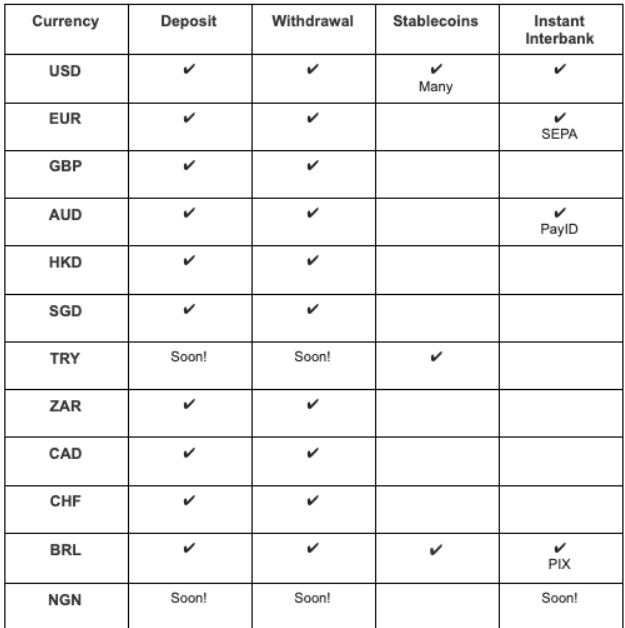What is driving the price of Ethereum? Bullish and Bearish Factors for Q4
The price of Ethereum continues to range, with no clear momentum in either direction. What are the possible bullish and bearish factors likely to impact ETH’s performance in Q4, 2023?
Ethereum (ETH) is currently the largest smart contract platform in the world by value of its native currency. Ether, the native currency that powers Ethereum, is also the second largest cryptocurrency in the world. Ethereum is also the largest smart contract chain by Total Value Locked (TVL) into Decentralized Finance (DeFi).
Ethereum currently has a market cap of ~US$201.3 billion, with each individual Ether currently priced at US$1583.17. Year to date the price of Ether is up ~32.0%. While YTD performance may suggest that ETH has had an excellent year, after hitting a cycle peak of ~US$2100 in April 2023, the price of the asset has steadily slid to a price level of around ~US$1600.
To evidence this middling 6-month period, if an investor was dollar cost averaging (DCA) Ether from the 1st of January, buying it weekly, they would be at a loss as of today. Dollar-cost averaging is the process of investing the same amount of money in a targeted asset at regular intervals over a certain period of time, regardless of price.
Buying US$10 of ETH weekly from January 1, 2023, to October 3, 2023, would have turned US$400.00 into ~US$392, resulting in a loss of ~4.1%.
Source: Brave new coin
Background
Ethereum was launched in 2015 and builds on the original blockchain innovations first introduced by Bitcoin.
Both Bitcoin and Ethereum allow users to exchange value without payment providers or banks. Ethereum, however, differs because it allows application developers to build decentralized applications. It is able to do this because it supports more complex, programmable transactions than Bitcoin. These more complex transactions are facilitated by smart contracts, which are self-executing ‘contracts’ where the terms of agreement or conditions are written into lines of code. The ‘contracts’ in this case can be considered similar to traditional contracts for value exchange with penalties and rules predetermined and ‘smart’ because they can be triggered automatically.
The project has humble beginnings. A whitepaper for the project was written by 19-year-old Canadian developer Vitalik Buterin in 2013. After successful funding rounds in 2014 powered by the concept of Ethereum’s vision of a new internet powered by decentralized applications, the project had its real coming out party in 2017 during the ICO bull run.
Because of its multi-purpose functionality, it became the platform of choice for Initial Coin Offerings, a method of fundraising blockchain projects through launching new tokens. With a swathe of highly successful projects conducting ICOs using Ethereum as a medium, value rushed into the network.
After the emergence of Decentralized Finance in 2019 and 2020, alongside a re-emergence of Non-Fungible tokens (NFTs) and Decentralized Autonomous Organizations (DAOs), in 2021, Ethereum once again experienced an extreme surge in value. While this bull run shared similarities with the bull run from 2017— a rush of value from developers and projects choosing to finance themselves using Ethereum — a distinguishing feature of this bull run was institutional interest in Ethereum.
During this period, for example, Real Vision Founder and noted Macro investor, Raoul Pal, said in an interview that the market cap of Ethereum could overtake that of Bitcoin by the next market cycle. A Former Goldman Sachs executive, Pal also said he believed Ethereum was the “greatest trade” setup that he has ever seen because cryptocurrency’s fundamentals suggested that it had an enormous value.
During 2021, Ethereum went from a fringe technology to one that was advocated and accepted by a growing number of legacy financial traders.
The story Now
Technological strength and developer popularity – Bullish
Despite six months of tepid price activity, Ethereum continues to evidence the powerful underlying macro fundamentals that Pal was referring to. “They’re two entirely different things. One is this pristine collateral store-of-value asset. The other one is basically a technology platform that’s the fastest-growing on Earth. Is that [second one] going to be worth more? Yeah,” explained Pal when referring to Ethereum.
Ethereum remains the de facto platform to build blockchain projects on top of. It is the oldest and most trusted smart contract blockchain and because of this it has a wealth of open source code available to replicate. It also has well-known tooling like OpenZeppelin and applications on Ethereum are more auditable than many other blockchains. It remains the gateway blockchain for most new entrants, particularly institutions and brands.
Despite having relatively higher costs and slower transaction processing speeds than many other comparable platform blockchains, Ethereum is also preferred thanks to its size and inherent security.
Venture Capital firm Electric Capital is highly regarded for its analysis of the Crypto/Blockchain developer ecosystem. As of June 2023, it reports that Ethereum has 5946 active developers working on it in total and that 1901 of these developers are full-time. This dwarfs the next most popular chain by total developers, Polkadot, which has 1923 total developers and 645 full-time ones.
The only other major blockchains comparable to Ethereum in terms of developer growth are smaller platforms with lower market caps like Cosmos and Solana.
In the last yearly report for crypto developers by Electric Capital, at the end of 2022, it measured that in the 4 years between 2018 and 2022, Ethereum experienced a more than 5 times increase in monthly active developers, from 1,084 to 5,819.
It is difficult to verify Pal’s assertion that Ethereum is the fastest-growing technology platform in the world. It is certainly the largest technology platform in the rapidly growing blockchain space but how it compares to other technology paradigms like Cloud and IoT is difficult to verify. Data from the State of Developer Ecosystem 2021 by Jetbrains would suggest, however, that it is much larger than IoT but much smaller than the cloud.
Ethereum, because of its incumbency as the most developed blockchain in the world, is in a strong position to be at the forefront of the Web3, Defi, NFT, and Metaverse revolutions. Groundbreaking apps like Compound, Opensea, and Decentraland were built on Ethereum first for a reason.
Prone to attacks- Bearish
While Ethereum is a technology platform that is growing in popularity it is prone to being exploited. On 20 July 2016, a reentrancy attack on the Ethereum DAO’s smart contract led to losses of 3.6 million ether (worth about US$50 million at the time). After initially blocking off the over 11 million within the DAO, the attacker made off with about a third of this by setting up a ‘Child DAO’ smart contract with a similar structure to the DAO. The attack led to community disagreements that forked Ethereum forever and led to a drop off in confidence across the Ethereum investment landscape.
While Ethereum developers have become better at writing smart contracts, there are still numerous vectors that attackers are targeting. An example is cross-chain bridging platforms. Bridging applications will generally be set up with smart contracts on either blockchain and an intermediary that communicates between the two.
Bridging technology has helped users shift from incumbent chains like Ethereum to new networks like Metis with a few clicks and through easy-to-navigate portals. Bridges have helped promote the growth of emerging blockchains like Metis, Moonbeam, and Optimism. While also offering relevance to Ethereum as a feeder blockchain.
Writing robust smart contracts across multiple blockchains, however, is no easy task. Bridging between blockchains is a complex operation with many moving parts. There are more points of failure and well-resourced hackers can often move faster than developers.
Recent years have seen the emergence of government-funded, professional hacking groups who will find ways to exploit any sort of smart contract flaw in a permissionless web3 application. Bridges, because of their complexity and the high value of fund movements, appear to be more prone to attacks than many other application types.
The biggest DeFi hack ever was a bridge attack tied to Ether. Over 170,000 Ether, worth ~US$600 million was lost during the Ronin bridge hack. Ronin is the native blockchain of the popular NFT-based game Axie Infinity. Many users swap between Ronin and Ethereum to cash out winning or deploy earnings.
Bearish – Ethereum’s ‘invisible tax’ – MEV
There are other attack vectors that have become very specifically tied to Ethereum, namely Maximal Extracted Value (MEV). MEV has been described as one of Ethereum’s biggest threats. It affects decentralization and the bottom line of honest users.
MEV refers to the maximum value that can be extracted from block production in excess of the standard block reward and gas fees by including, excluding, and changing the order of transactions in a block. By reordering transactions, value can be lost or gained by small amounts each time that steadily accrue. In 2022, according to Eigen Research MEV bots generated revenue of at least $307 million on Ethereum. This revenue was taken from honest everyday users which is why MEV is often called the invisible tax.
In today’s Ethereum, Validators (previously miners) have the power to reorder or select transactions waiting in the mempool. The mempool can be described as the viewable pool of transactions submitted to a blockchain network that is valid and waiting to be added to the chain by miners or validators.
Independent network participants known as "searchers" are core to how MEV manipulators capture value. Searchers run complex algorithms that will seek out MEV opportunities across Ethereum and have bots automatically submit those profitable transactions to the network. An example of an MEV profit opportunity may be DEX arbitrage or a flash loan opportunity. DEX arbitrage would for example entail a difference in the exchange rate between an ETH/AXIE pair between two exchanges on Ethereum.
MEV bots will pay extra to validators to process transactions that capture their profit opportunity first from the mempool before it dissipates. The MEV landscape is competitive and searchers are willing to pay up to 90% of the revenue they may gain from vectors like DeFi arbitrage. Searchers and validators both earn from this process but users on the applications like traders, stakers, and liquidity providers tend to lose out.
It should be noted that other smart contract blockchains with DeFi arbitrage and other application-based MEV opportunities like Solana also suffer from MEV challenges.
There is also a danger that MEV bots are censoring Ethereum transactions. A number of MEV bot services work by building proposer/block-builder separation (PBS) tooling.
A block proposer, or Ethereum validator in a proof-of-stake network, can increase their ETH staking rewards by up to 60% by selling blockspace to a pool of block builders. The separation of Block proposers and block builders is a technical solution implemented post-merge.
The problem to some with many PBS-based MEV bots, including industry leader Flashbots, is that they openly state they will refuse to include transactions deemed to be forbidden by the USA’s Office of Foreign Assets Control (OFAC). This can include transactions that are a part of the Tornado Cash mixing service built to make Ethereum transactions more private and less traceable. There is evidence to suggest that Tornado Cash was used by Money Launderers and Cyber Criminals from nations like North Korea.
31% of the Ethereum blocks in the last month have been OFAC compliant.
Neutral: Ethereum is just a higher beta version of Bitcoin
Ethereum and Bitcoin are fundamentally different assets but they are strongly correlated.
Both Bitcoin and Ethereum allow users to exchange value without payment providers or banks. Ethereum, however, differs because it allows application developers to build decentralized applications. It is able to do this because it supports more complex, programmable transactions than Bitcoin.
Ethereum’s value proposition is much broader than Bitcoin’s and covers the range of Web3 including DeFi, NFTs, Metaverse projects, and new token launches. Bitcoin offers purity, deeper decentralization, a manageable roadmap, and a truly decentralized, public digital currency that has the best chance of being adopted over fiat.
Investors, however, tend to group Ethereum and Bitcoin together as ‘risk assets’ or assets with a tendency to fluctuate more than the market baseline. Mainstream investors, both institutional and retail tend to lump the two assets and other digital assets together as ‘crypto’
Particularly during periods of market turmoil, BTC and Ether tend to be sold together. This may be down to a lack of broad understanding of how the two assets work and their significant differences.
Over the last year, the correlation between Bitcoin and Ethereum has hovered between 0.8-0.95. This is objectively high and suggests that the two assets are currently moving in step with each other.
Source: Coinmetrics
Bitcoin has outperformed Ethereum and is up ~65.6% year-to-date. The original digital asset has observed greater resilience during the post-April period of bearish market activity. The two assets, however, have broadly shared similar characteristics of record-low volatility this year.
Source: Glassnode
Source: Glassnode
Above are charts for Ethereum and Bitcoin’s Realized Volatility. This is the standard deviation of returns measured against the mean return of a market. High values in realized volatility indicate a phase of high risk in that market.
Here, Glassnode calculates the realized volatility based on daily returns and multiplies it with a factor of sqrt(365) to yield the annualized daily realized volatility over a rolling window of 2 weeks. For both assets, volatility has been muted for most of 2023.
Both Ethereum and Bitcoin have had to deal with characteristics of an uncertain global macroeconomic environment where it is uncertain whether major economies will face or when interest rate hikes will end. This has reduced mainstream interest in risk assets. Additionally, cyclical interest in blockchain technology has cooled following booms in 2022, not helped by the scandalous Luna/Terra and FTX incidents.
Both assets and crypto in general, are dealing with lukewarm demand as evidenced by the lower volatility.
**Bullish: The Triple Halving and Ethereum’s Ultrasound Money Characteristics **
In September 2022, the Merge upgrade was implemented on the Ethereum blockchain. The Ethereum Foundation states that the Merge will be ‘the most significant upgrade in the history of Ethereum.’ The Merge will witness the joining together or ‘merging’ of the execution layer, Ethereum as we know it today, with a consensus layer called the Beacon chain.
The Beacon chain uses a Proof-of-Stake (PoS) consensus model that will replace the current Proof-of-Work (PoW) model that the mainnet currently uses. The switch to PoS will replace energy-intensive mining, and instead secure the network with staked ETH.
The bitcoin halving is pivotal in crypto markets because of the strong positive effect it has on the price of BTC. It occurs approximately every 4 years and cuts the supply rate of new Bitcoin in half. The halving reduces the rate of inflation and like clockwork, creates upward price pressure for Bitcoin.
Ethereum underwent something similar to a halving type of effect with the transition to Proof-of-Stake (PoS) leading up to the merge. Calculations from some analysts suggest that the inflation rate cut to Ethereum will be the equivalent of “three Bitcoin halvings.”
PoS makes securing the network much cheaper than with Proof-of-Work, and because of this, PoS validators are paid far less than PoW miners. Because of Ethereum’s existing free burn model introduced as part of the London Hard Fork and EIP-1559, the supply impact of the Merge is set to be even more exaggerated. With less ETH being issued and the asset now being burnt, the potential for an ETH supply shock was massive.
The dashboard for Ultrasound.money, gives us insight into the rate of new supply and the simulated rate if Ethereum didn’t switch to Proof-of-Stake.
Source: Ultrasound.money
Source: Ultrasound.money
The difference in new yearly supply of Ether with the new Proof-of-Stake compared with Proof-of-Work is estimated to be around 94% less.
If transaction activity is high enough then there is a possibility that Ethereum switches to becoming deflationary, meaning it has a negative inflation rate. This has occurred on numerous occasions in the last year. This should further buoy the price appeal of Ethereum.
Other factors driving the price of Ethereum
Bullish
- Staking rewards for Ether
Currently, anyone holding Ether can delegate it to a Validator and earn a share of their Proof-of-Stake consensus earnings. Holders can currently earn ~3.8% on any Ether they stake. ~22% of all Ether is locked into staking. This ratio is low because once Ether is staked it cannot be used for activities like paying for gas. Native staking rewards add more value to a token as a store of value. More Ether staked also restricts the available supply of Ether and increases its supply.
- Layer-2 solutions boost the scaling capabilities of Ethereum
Layer 2 refers to any secondary framework or protocol built on top of an existing blockchain that adds features that improve the scaling capabilities of the base chain. Base layer blockchains like Ethereum can slow down and become expensive when they are congested because of events such as popular NFT drops. Layer 2s are booming. The value of assets being deployed onto layer 2 platforms is hitting unprecedented levels in the billions of dollars. Layer-2’s boost the value of networks like Ethereum by moving transactions off them. Ethereum, if layer-2’s continue to flourish, should be in a good position to absorb rising transactions during the next bull run.
Bearish
- Other Smart contract blockchains pull value away from Ethereum
Other smart contract networks like Solana, Polkadot, and Cosmos offer compelling alternatives to Ethereum. They offer faster and cheaper transactions, alternative architecture, more accessible programming languages for programmers, greater scalability, and many other advantages designed to improve upon Ethereum. Ethereum is the earliest version of blockchain technology and over time new flasher alternatives have and will arrive. This may pull money away from Ether.
- Is Ethereum censorship resistant?
As mentioned earlier, certain MEVbots publicly state they censor transactions that OFAC deems as non-compliant. Beyond this, Ethereum development platforms like Infura and Circle have stated they will ban Ethereum addresses believed to be attached to cyber criminals and illegal activity. Censorship resistance is a core tenant to blockchains and a decentralized ethos. In many users’ views, an entity like OFAC should not decide what is and isn’t allowed on the Ethereum network. If this trend continues Ethereum, may in some way have to pick sides during global conflicts, or will simply have to bend the knee if the US government decides transactions from a particular group should not be published on the network.
Conclusion
Ethereum’s narrative in 2023 has played out as a mix of bullish and bearish signals, reflecting the evolving nature of this pioneering blockchain platform. The ecosystem’s resilient development community, institutional interest, and cutting-edge upgrades like the Merge have solidified its position in the rapidly evolving digital landscape. Ethereum’s adaptability and integration with Layer-2 solutions illustrate a blockchain that’s not static but evolving, indicative of its potential to scale and adapt.
However, this optimism is tempered by existing vulnerabilities, notably security challenges and the contentious issue of MEV – an ‘invisible tax’ that threatens user experience and the blockchain’s decentralized ethos. The platform’s correlation with Bitcoin underscores its susceptibility to broader market sentiments and macroeconomic factors, painting a picture of a digital asset still in the throes of maturation. Whether Ethereum is now censorship resistant because of its clear OFAC compliance approach will divide opinions but it is ultimately turning many original users away from the network who initially joined it because it promised a more free internet.
The future of Ethereum is likely not going to be linear. Investor sentiment is likely to continue to ebb and flow. Ethereum, however, remains central to the conversations and innovations shaping the future of the digital economy.

Don’t miss out – Find out more today










